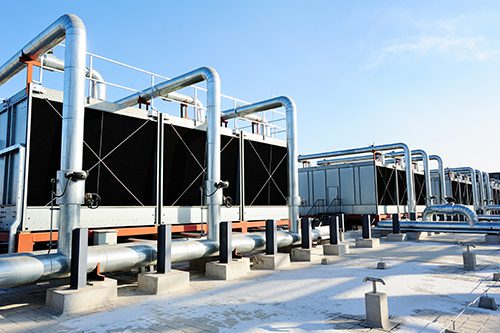Are you looking for ways to make your cooling system more sustainable? As more and more industries are seeking ways to improve efficiency and meet environmental goals, sustainable water treatment practices have evolved to meet demand.
Methods and Considerations for Sustainable Cooling
There are three principal paths to consider when making your cooling system more sustainable:
- Increasing cooling tower cycles of concentration (acid feed pH control)
- Using alternative/non-conventional makeup water sources
- Cascading cooling towers
Increasing Cooling Tower Cycles of Concentration

Figure 1 shows that after six or seven cycles of concentration, the water savings potential is small compared to the increase in circulating water contaminant concentrations.
The graph in Figure 1 represents the following equation:
Makeup = Evaporation + Blowdown
Sodium Zeolite Softening
Sodium zeolite softening is one method of increasing cycles of concentration. Reducing calcium and magnesium in the cooling tower makeup stream usually translates to higher cycles if hardness-related scaling saturation indices are the limiting factors (LSI, MgSiO3, CPSI). If another water component, such as chloride, silica, or conductivity/TDS, is the limiting factor, then water softening may not lead to higher cycles of concentration.
To increase cycles of concentration:
- Remove hardness from the makeup water using softeners
- Limit calcium carbonate scale formation
- Replace hardness with sodium
- Hardness is calcium and magnesium (temporary hardness caused by bicarbonates of calcium and magnesium ions)
- Regenerant is salt (sodium chloride)
- Exchange of ions (nothing created or destroyed)
Partial softening via sodium zeolite ion exchange aims to reduce:
- The aggressive/corrosive nature of makeup water
- Regeneration frequency and salt usage
- Dosage concentration of corrosion inhibitor active treatment components
The following factors should be considered before softening:
- Salt delivery cost
- Water used during resin regeneration cycles
- 100% softened makeup water is highly aggressive to low carbon steel piping and cooling tower system components
- Softener upsets will lead to rapid scaling if not detected immediately, as the treatment program is not designed for high scaling potential
As previously mentioned, the incoming makeup water can be partially softened to mitigate the risk of softener upset. Partial softening can be achieved by mixing valves to add raw makeup water to the 100% soft water effluent from the softener. The softening percent is determined by system conditions and desired cycles of concentration.
Acid Feed
Acid feed for control at a specific pH can enhance the performance of inorganic corrosion inhibitors, such as orthophosphate, and maintain their solubilities and overall efficacy.
Reasons for Acid Feed
- Control calcium carbonate (CaCO3) scaling in industrial cooling
- Control calcium phosphate (Ca3(PO4)2) scale (cycles can be increased)
- Help control zinc precipitation
- Improve the effectiveness of chlorine and hypochlorite for microbiological control
- Improve corrosion inhibition with orthophosphate
- Orthophosphate gamma iron oxide film formation is strongest at pH 6.8–7.2
Acid feed can be aggressive to various system materials because it is highly dense. This may cause it to attack the concrete basin floor. Acid feed dilution can help alleviate these challenges.
Benefits of an Acid Dilution System
- Lower cost by reducing acid requirement
- Run at low alkaline pH to reduce corrosion inhibitor requirement
- May need to feed slightly higher scale inhibitor dose, but at threshold concentrations
- Reduce circulating cooling water corrosive potential
Limited pH reduction (low alkaline range) acid feed is comparable to partial water softening.
Alternative/Non-Conventional Makeup Water Sources for Sustainable Cooling
Using the following makeup water sources may help enhance cooling sustainability:
- Gray water (on-site process waste streams)
- Reverse osmosis (RO) permeate
- RO concentrate/reject
- Municipally supplied wastewater
Potential Benefits of Using Gray Water
- Reduce/eliminate demand for municipally supplied water
- Reduce requirement for gray water discharge
- Potentially realize large financial savings, proportional to the size and evaporative heat load placed on the cooling tower system in question
- Cycled PO4 serves as mild steel corrosion inhibitor, and, if high enough, can act anodically in the role of passivator in a neutral pH environment
- Demonstrate responsible environmental stewardship
Gray water usually contains an elevated PO4 component. This means it can serve as a mild steel corrosion treatment component when cycled (benefit). But it may also require higher dose concentrations of dispersant when cycled (challenge).
Potential Challenges of Using Gray Water
- Increased potential for phosphate-related fouling
- Increased polymeric dispersant residual
- May require acid feed for pH control
- Cycled PO4 is a potential microbial nutrient
Potential Benefits of Using Reverse Osmosis Permeate
- Incorporate makeup water largely devoid of all potentially detrimental ionic species
- Eliminate corrosive monovalent anions (chloride) and, by default, divalent ions such as sulfate
- Allow for exceptionally high cooling tower cycling, significantly reducing supply water usage and subsequent cooling tower blowdown (discharge)
- Demonstrate responsible environmental stewardship
Potential Challenges of Using Reverse Osmosis Permeate
- Excess system leakage, cooling tower drift, and windage losses may contribute to unachievable elevated cycles of concentration
- High unit water cost
- More aggressive water requires higher corrosion inhibitor residuals
Potential Benefits of Using Reverse Osmosis Concentrate (Reject)
- Avoid potential wastewater discharge/treatment costs (partial, as there will still be cooling tower blowdown)
- Reduce the quantity of conventionally sourced makeup water to the cooling tower (and associated costs)
- Can be blended with clean water to produce acceptable cooling tower makeup water quality
- Demonstrate responsible environmental stewardship
Potential Challenges of Using Reverse Osmosis Concentrate (Reject)
- RO reject can reduce attainable cycles of concentration if the quantity represents a large percentage of the total makeup water requirement
- Supplied RO reject serving as makeup water is typically cycled four times
- Corrosion rates can rise significantly, depending on the cycled residual concentrations of aggressive anions (chloride and sulfate)
- The cooling tower treatment program will need to incorporate potentially higher active residual concentrations of corrosion inhibitor(s) and dispersants
Potential Benefits of Using Municipal Wastewater
- Likely eliminates the use of conventionally sourced makeup water to the cooling tower and associated costs
- This water is typically disinfected and of fairly good quality as compared to typical city water of potable quality
- May contain elevated PO4 residual concentration, carrying similar benefits observed with gray water
- Demonstrate responsible environmental stewardship
Potential Challenges of Using Municipal Wastewater
- Some detrimental water constituents may be significantly elevated (conductivity, PO4, chloride)
- High PO4 requires increased polymeric dispersant residuals to maintain phosphate solubility
- pH control is typically required
- Automated acid feed system will be required, as discussed earlier
- The cooling tower treatment program will need to incorporate potentially higher active residual concentrations of corrosion inhibitor(s) and dispersants, as well as provision for commodity sulfuric acid
Cascading Cooling Towers for Enhanced Cooling Sustainability
How It Works
A pair of cooling towers are placed in a series. The first cooling tower receives makeup water from the water source used at the facility and is cycled. The second cooling tower uses the first cooling tower’s blowdown as its makeup water source. This limits the achievable cycling degree but may also reduce the overall water usage. The process effectiveness can be determined by the makeup water quality being used by the first cooling tower.

Treatment carryover is key in cascading cooling towers. If the inhibitors remain in their soluble form, they remain usable in the second tower’s treatment program.
Small supplemental chemical additions may be required, especially if higher levels of dispersants or corrosion inhibitors are required. Oxidizing biocides will normally be fed to both cooling towers, and any nonoxidizing biocide from the first tower may be used in the second tower depending on contact time requirements being met.
Cooling Sustainability Summary
Cooling towers offer facilities various techniques for reducing the usage of conventional water sources as makeup. This can help you achieve your environmental goals.
Cooling towers can also serve as an economical means of solids concentration when employing the most effective means of system heat removal.
When evaluating your cooling system for sustainability improvements, the following factors are important to keep in mind:
- Data must be the driving and determining factor when evaluating which options to implement for maximum sustainability and performance reliability
- An honest evaluation considering all factors in the total cost of operation and implementation equation is essential to achieving long-term sustainability goals
As with all other technologies, it is necessary to practice due diligence when determining the feasibility of utilizing methods. Always consult your equipment manuals and guides and reach out to the ChemTreat team for help!


